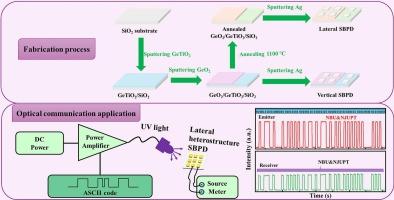基于GeTiO2垂直和横向异质结的双波长太阳盲光电探测器
IF 6.9
2区 材料科学
Q2 CHEMISTRY, PHYSICAL
引用次数: 0
摘要
宽禁带异质结太阳盲探测器(sbpd)正被积极探索,以实现在军事和民用领域的广泛应用。然而,在垂直异质结构堆积过程中产生的界面缺陷会降低SBPD的性能。本文采用射频磁控溅射策略制备了GeTiO2垂直和横向异质结sbpd,并表现出明显的双波长太阳盲光响应。与垂直异质结SBPD相比,GeTiO2横向异质结SBPD已经证明大大增强表演包括好的photoresponsivity 2.01 × 10−2和4.5 × 10−4 A / W,探测能力高2.07 × 1010和5.7×108 琼斯,和大的外部量子效率 % 11.7和0.22在213年和254年 纳米界面缺陷的减少和调整乐队安排。此外,由于响应时间短,GeTiO2横向异质结sbpd成功地实现了二进制编码信息传输和光电子逻辑器件的应用。我们的工作提出了一种制造高性能横向异质结sbpd的可行策略,为开发光电应用的氧化物半导体异质结构的设计提供了新的见解。本文章由计算机程序翻译,如有差异,请以英文原文为准。

Dual-wavelength solar blind photodetectors based on GeTiO2 vertical and lateral heterojunctions
Wide bandgap heterojunction solar blind photodetectors (SBPDs) are actively being explored to achieve widespread applications in the military and civilian fields. However, interface defects induced during the stacking process of the vertical heterostructure reduce the SBPD performance. Here, GeTiO2 vertical and lateral heterojunction SBPDs have been fabricated by using the radio frequency magnetron sputtering strategy and exhibit obvious dual-wavelength solar-blind photoresponses. Compared to the vertical heterojunction SBPD, the GeTiO2 lateral heterojunction SBPD has been demonstrated substantially enhanced performances including good photoresponsivity of 2.01 × 10−2 and 4.5 × 10−4 A/W, high detectivity of 2.07 × 1010 and 5.7 × 108 Jones, and large external quantum efficiency of 11.7 and 0.22 % at 213 and 254 nm due to the decreased interface defect and adjusted band arrangement. Besides, benefiting from their short response time, GeTiO2 lateral heterojunction SBPDs successfully achieve binary-encoded information transmissions and optoelectronic logic device applications. Our work presents a feasible strategy for fabricating high-performance lateral heterojunction SBPDs, offering new insights into the design of oxide semiconductor heterostructures for developing optoelectronic applications.
求助全文
通过发布文献求助,成功后即可免费获取论文全文。
去求助
来源期刊

Applied Surface Science
工程技术-材料科学:膜
CiteScore
12.50
自引率
7.50%
发文量
3393
审稿时长
67 days
期刊介绍:
Applied Surface Science covers topics contributing to a better understanding of surfaces, interfaces, nanostructures and their applications. The journal is concerned with scientific research on the atomic and molecular level of material properties determined with specific surface analytical techniques and/or computational methods, as well as the processing of such structures.
 求助内容:
求助内容: 应助结果提醒方式:
应助结果提醒方式:


